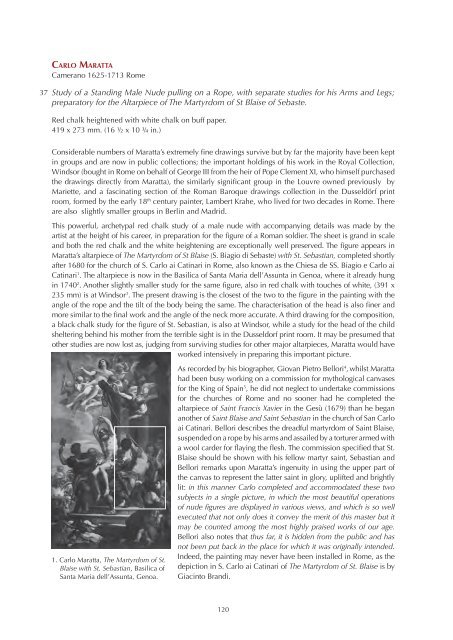Catalogue-2014-Jean-Luc-Baroni
- No tags were found...
You also want an ePaper? Increase the reach of your titles
YUMPU automatically turns print PDFs into web optimized ePapers that Google loves.
37<br />
Carlo Maratta<br />
Camerano 1625-1713 Rome<br />
Study of a Standing Male Nude pulling on a Rope, with separate studies for his Arms and Legs;<br />
preparatory for the Altarpiece of The Martyrdom of St Blaise of Sebaste.<br />
Red chalk heightened with white chalk on buff paper.<br />
419 x 273 mm. (16 ½ x 10 ¾ in.)<br />
Considerable numbers of Maratta’s extremely fine drawings survive but by far the majority have been kept<br />
in groups and are now in public collections; the important holdings of his work in the Royal Collection,<br />
Windsor (bought in Rome on behalf of George III from the heir of Pope Clement XI, who himself purchased<br />
the drawings directly from Maratta), the similarly significant group in the Louvre owned previously by<br />
Mariette, and a fascinating section of the Roman Baroque drawings collection in the Dusseldörf print<br />
room, formed by the early 18 th century painter, Lambert Krahe, who lived for two decades in Rome. There<br />
are also slightly smaller groups in Berlin and Madrid.<br />
This powerful, archetypal red chalk study of a male nude with accompanying details was made by the<br />
artist at the height of his career, in preparation for the figure of a Roman soldier. The sheet is grand in scale<br />
and both the red chalk and the white heightening are exceptionally well preserved. The figure appears in<br />
Maratta’s altarpiece of The Martyrdom of St Blaise (S. Biagio di Sebaste) with St. Sebastian, completed shortly<br />
after 1680 for the church of S. Carlo ai Catinari in Rome, also known as the Chiesa de SS. Biagio e Carlo ai<br />
Catinari 1 . The altarpiece is now in the Basilica of Santa Maria dell’Assunta in Genoa, where it already hung<br />
in 1740 2 . Another slightly smaller study for the same figure, also in red chalk with touches of white, (391 x<br />
235 mm) is at Windsor 3 . The present drawing is the closest of the two to the figure in the painting with the<br />
angle of the rope and the tilt of the body being the same. The characterisation of the head is also finer and<br />
more similar to the final work and the angle of the neck more accurate. A third drawing for the composition,<br />
a black chalk study for the figure of St. Sebastian, is also at Windsor, while a study for the head of the child<br />
sheltering behind his mother from the terrible sight is in the Dusseldorf print room. It may be presumed that<br />
other studies are now lost as, judging from surviving studies for other major altarpieces, Maratta would have<br />
worked intensively in preparing this important picture.<br />
1. Carlo Maratta, The Martyrdom of St.<br />
Blaise with St. Sebastian, Basilica of<br />
Santa Maria dell’Assunta, Genoa.<br />
As recorded by his biographer, Giovan Pietro Bellori 4 , whilst Maratta<br />
had been busy working on a commission for mythological canvases<br />
for the King of Spain 5 , he did not neglect to undertake commissions<br />
for the churches of Rome and no sooner had he completed the<br />
altarpiece of Saint Francis Xavier in the Gesù (1679) than he began<br />
another of Saint Blaise and Saint Sebastian in the church of San Carlo<br />
ai Catinari. Bellori describes the dreadful martyrdom of Saint Blaise,<br />
suspended on a rope by his arms and assailed by a torturer armed with<br />
a wool carder for flaying the flesh. The commission specified that St.<br />
Blaise should be shown with his fellow martyr saint, Sebastian and<br />
Bellori remarks upon Maratta’s ingenuity in using the upper part of<br />
the canvas to represent the latter saint in glory, uplifted and brightly<br />
lit: in this manner Carlo completed and accommodated these two<br />
subjects in a single picture, in which the most beautiful operations<br />
of nude figures are displayed in various views, and which is so well<br />
executed that not only does it convey the merit of this master but it<br />
may be counted among the most highly praised works of our age.<br />
Bellori also notes that thus far, it is hidden from the public and has<br />
not been put back in the place for which it was originally intended.<br />
Indeed, the painting may never have been installed in Rome, as the<br />
depiction in S. Carlo ai Catinari of The Martyrdom of St. Blaise is by<br />
Giacinto Brandi.<br />
120
















